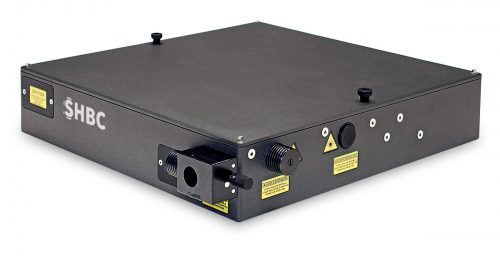Sum-frequency generation (SFG) spectroscopy is used to assess the vibrational properties of surfaces and interfaces with a monolayer sensitivity. Unlike Raman spectroscopy that is sensitive to the bulk properties, SFG spectroscopy is exquisitely sensitive to the physical and chemical properties of molecular layers at surfaces and interfaces where inversion symmetry is broken.
In SFG spectroscopy, a mid-IR beam is sent onto the surface or interface where it is overlapped with a visible beam. The specific properties of the resulting sum-frequency signal, such as polarization and intensity, provide information on dipole orientation and vibrational spectra at the surface. SFG is a second-order nonlinear process and is allowed only when inversion symmetry is broken, making it a specifically surface-sensitive method. In this type of spectroscopy, one of the pulses is required to have a sufficiently narrow spectral bandwidth in order to obtain a high spectral resolution and, subsequently, distinguish the vibrational fingerprints of the investigated molecules.
One of the main scientific targets of SFG spectroscopy is studying the dynamics of interfacial water, which is done by observing the OH stretching vibrations of normal water and OD stretching vibrations of heavy water at 2.6 – 3.5 μm and 3.5 – 4.5 μm, respectively. Other spectral ranges of interest are 4.5 – 5.5 μm, where the vibrations of metal carbonyls and nitriles occur, and 5.5 – 6.5 μm, where molecular vibrations of interfacial biomolecules take place. Moreover, going further into the mid-IR is also of high interest due to lower frequency biomolecular vibrations.
Broadband mid-IR source such as ORPHEUS-MIR, pumped by PHAROS or CARBIDE laser, covers the spectral ranges of interest and addresses many vibrational levels at once, while SHBC is used to double the laser frequency and narrow down the spectral bandwidth to match the aforementioned requirements. In this configuration, the SFG signal is generated in the visible spectral range, eliminating the need for complex infrared detection.
- 高重复频率下的宽带中红外脉冲
- 2500 – 15000 nm 连续可调
- 波长 2000 nm 短脉冲高能量输出
- 工业级激光器泵浦,稳定性高
- 可选配 CEP 稳定
- 515 nm 输出
- 飞秒泵浦可输出皮秒脉冲
- 带宽 < 10 cm-1 或 < 2 cm-1
- 占地面积小
- 在中红外波段(1350 – 16000 nm)具有高转换效率
- 满足所有需求的高能量、高功率型号
- 单脉冲 – 2 MHz 重复频率
- 高达 80 W 的泵浦功率
- 高达 2 mJ 泵浦能量
- 189 nm – 20 μm 可调波长
- 高达 6 mJ 的泵浦能量
- > 25% 转换效率
- 高稳定性输出
- 闲频光 CEP 稳定功能
- 100 fs – 20 ps 连续可调脉宽
- 最大单脉冲能量 4 mJ
- 最小脉宽输出 < 100 fs
- POD 和 BiBurst 功能
- 高达 5 次谐波或可调谐扩展
- CEP 稳定或重复频率锁定
- 热稳定性和密封设计
Peptide Orientation at Emulsion Nanointerfaces Dramatically Different from Flat Surfaces
T. W. Golbek, K. Strunge, A. S. Chatterley, and T. Weidner, The Journal of Physical Chemistry Letters 46 (13), 10858-10862 (2022).
Direct imaging of electric field behavior in 2,7-diphenyl[1]benzothieno[3,2-b][1]benzothiophene organic field-effect transistors by sum-frequency generation imaging microscopy
C. Katagiri, T. Miyamae, H. Li, F. Yang, and S. Baldelli, Physical Chemistry Chemical Physics 8 (23), 4944-4950 (2021).
Influence of Microcrystallinity on the CO/Pt(poly) Electrode Surface Using Sum Frequency Generation Microscopy Combined With Electrochemistry
H. Li, and S. Baldelli, The Journal of Physical Chemistry C (2021).
In Situ Spectroscopic Probing of Polarity and Molecular Configuration at Aerosol Particle Surfaces
Y. Qian, G. Deng, and Y. Rao, The Journal of Physical Chemistry Letters 16 (11), 6763-6771 (2020).
Robust Binding of Disulfide-Substituted Rhenium Bipyridyl Complexes for CO2 Reduction on Gold Electrodes
M. Cattaneo, F. Guo, H. R. Kelly, P. E. Videla, L. Kiefer, S. Gebre, A. Ge, Q. Liu, S. Wu, T. Lian et al., Frontiers in Chemistry 8 (2020).
High-resolution and high-repetition-rate vibrational sum-frequency generation spectroscopy of one- and two-component phosphatidylcholine monolayers
F. Yesudas, M. Mero, J. Kneipp, and Z. Heiner, Analytical and Bioanalytical Chemistry 19 (411), 4861-4871 (2019).
Interfaces of Gas–Aerosol Particles: Relative Humidity and Salt Concentration Effects
Y. Qian, G. Deng, J. Lapp, and Y. Rao, The Journal of Physical Chemistry A 29 (123), 6304-6312 (2019).
Plasmonic Effects of Au Nanoparticles on the Vibrational Sum Frequency Spectrum of 4-Nitrothiophenol
M. Linke, M. Hille, M. Lackner, L. Schumacher, S. Schlücker, and E. Hasselbrink, The Journal of Physical Chemistry C 39 (123), 24234-24242 (2019).
Vibrational Energy Redistribution between CH Stretching Modes in Alkyl Chain Monolayers Revealed by Time-Resolved Two-Color Pump–Probe Sum Frequency Spectroscopy
M. Lackner, M. Hille, and E. Hasselbrink, The Journal of Physical Chemistry Letters 1 (11), 108-112 (2019).
Vibrational sum-frequency generation spectroscopy of lipid bilayers at repetition rates up to 100 kHz
F. Yesudas, M. Mero, J. Kneipp, and Z. Heiner, The Journal of Chemical Physics 10 (148), 104702 (2018).





